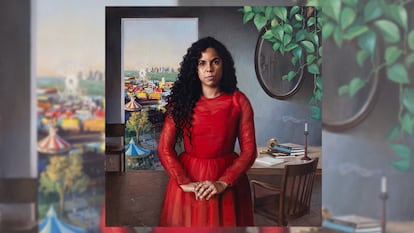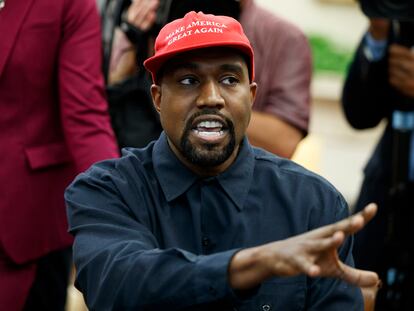Danay Suárez, the atypical Cuban rapper who converted to Christianity and takes exception with ‘TikTok culture’
On her sixth album ‘Cambio’, which she considers “the most powerful of my career”, she calls out artists who, she says, are making careers out of selling vice and violence in songs for adolescents

In 2016, Danay Suárez arrived at a point in her life where nothing seemed to make sense and everything seemed predictable. Screaming inwardly, she asked God “if He existed, to reveal himself, because I didn’t want to live anymore,” though she didn’t want to die, either. She was only looking to fill the spiritual vacancies that neither fame nor money could fill. From that moment on, she says, she accepted Jesus as her only savior. “I had never before felt such peace and security, not even through meditation,” says the rapper.
The atypical emcee has spent the last four years between Miami and Havana, working on the creation of her sixth album, Cambio. It has been a period of apparent silence for her, during which she has taken the time to create, work outside the bounds of the music industry and put together a project of which she speaks with profound satisfaction.
On July 7, the album was launched on digital platforms, a dissident manifesto that takes aim at new trends on social media, the ones that go viral on TikTok and Instagram. “It’s a real weapon meant to be demystified and decoded with a kind of intelligence that is being replaced by artificial intelligence,” says the singer about the release, which she considers “the most powerful of my career.”
Throughout its 10 songs, Danay dives into an auditory-visual-spiritual journey that transcends the borders of rap to experiment with an amalgam of sounds, mixing trip hop, filin, techno, trap and reggae; all in a harmonious, coherent dialogue that unfurls with every track. Her lyrics go unapologetically to the heart of the social and spiritual issues that concern her. She has been labeled a fundamentalist fanatic for her views on abortion and the definition of family, but here, she reaffirms her right to express that message of faith and discontent with modern dystopias. Is this sermon right or wrong? The answer lies in the listener who judges and interprets the work. She takes on each of her words, lives by them and then, releases them into the air for anyone to hear.
Family is one of the concepts for which the singer advocates in her discourse, and in the making of Cambio, she underlined its importance. The album’s musical production was overseen by her husband, Cuban pianist and composer Jesús Pupo, who crafted the songs without using the sampling so characteristic of hip hop and other related genres. “He composed the tracks from classical elements and added the folkloric energy without any religious overtones. The work was finished with the detailed mastering of one of the best in the game, Mike Fuller, in the city of Miami,” says Suárez.
Its visual identity, expressed through YouTube videos, was designed to be a cinematographic series, but in reality, each clip functions as an independent piece. “Every visual aspect of the album has been carefully considered in order to create a complete and immersive experience that compliments the music and the message. The lighting in the videos was designed by Ledián Fernández and Ever Fernández, who was also in charge of filming. The visual edition achieves a poetically elevated tone with the direction of Asiel Babastro, especially in the music video for the song Vine A,” says the rapper.
The album’s cover is an oil painting by Jesús Emmanuel Villarreal, who studied art and painting at the Academy of Art in Florence. It is a portrait of the artist with her back to an amusement park that can be interpreted as a reflection of modern society. Danay, who has controlled every aspect of the project, says that her idea was, “to make a sarcastic observation of the Baroque period through the music, color palette and painting technique, communicating that society is very baroque, with a lot of exterior ornamentation and little inner essence.”
Nadie es dueño de nadie (No one owns anyone) is the album’s sixth song. The track incorporates rumba into the project’s spectrum of sounds. Many people, after converting to Christianity, reject the folkloric elements of other cultures, but for this rapper, “limiting artistic expression through religious insularity is a fatal mistake.”
“I follow Jesus and believe in Him, but I’m not religious,” says the singer. “On this rumba [track], I don’t adore any deity created by human imagination, but I do celebrate the gift that God has given musicians to advance such an important legacy like that of rumba, which is recognized worldwide as cultural heritage.”
Suárez has decided to distance herself from the music industry, betting instead on an independent career. Vine A serves to announce this plan. With trap and drill influences, the song questions artists who make a career off of selling vice and violence through songs primarily consumed by a teenage public. “No eres caliente, ni eres frío/eres un link que lleva al vacío (You’re not hop, you’re not cold/you’re a link to the void)” goes one of its verses, in which she dares to question today’s mainstream art consumed by young generations and its future consequences.
For many artists, signed with a major label like Universal Music is the dream. But Suárez’s experience with the company was one of the triggers that led her to carve out her own path. “I decided I had to leave when I noticed that they were selling the world a blown-up bubble, an illusion, and that independently, I could at least bring a message and artistic expression to fruition.”
“I never imagined that my music would end up shelved away like so many others by the company, when my sound was a reference for many Latino artists who followed it up with similar sounds, morally open to doing anything to achieve fame and success. One example of this was when Yo Aprendí (I Learned), one of my most popular songs, which I trademarked with Universal in 2013, but they only listened to in 2019 when Karol G sang on it on her album Ocean in a collaboration with me,” she laments.
When an artist decides to work independently, sometimes the public assumes that it’s because their music isn’t commercial, which forms their image of the performer, even leading them to get mad with the artist if they see them as having left the underground. But Suárez isn’t afraid of labels. “The genres on this album can be commercialized and danced to. It isn’t an underground album, totally the opposite,” she says. “It’s an album that elevates international sound to such professional levels that it redefines música urbana and has significant content.”
Proof of this lies in the plays that Cambio has racked up on digital platforms. At a little over a week after its release, it has more than 300,000 organic streams on Spotify. In comparison with other international artists, Suárez’s audience may be smaller, but they’re loyal and they’re paying attention. The rapper’s goal is for her message to be heard in the most remote barrio, by a listener who likes a good rumba, rather than in a club by someone who is thinking about getting high to be able to locate the positivity in its lyrics.
Sign up for our weekly newsletter to get more English-language news coverage from EL PAÍS USA Edition
Tu suscripción se está usando en otro dispositivo
¿Quieres añadir otro usuario a tu suscripción?
Si continúas leyendo en este dispositivo, no se podrá leer en el otro.
FlechaTu suscripción se está usando en otro dispositivo y solo puedes acceder a EL PAÍS desde un dispositivo a la vez.
Si quieres compartir tu cuenta, cambia tu suscripción a la modalidad Premium, así podrás añadir otro usuario. Cada uno accederá con su propia cuenta de email, lo que os permitirá personalizar vuestra experiencia en EL PAÍS.
¿Tienes una suscripción de empresa? Accede aquí para contratar más cuentas.
En el caso de no saber quién está usando tu cuenta, te recomendamos cambiar tu contraseña aquí.
Si decides continuar compartiendo tu cuenta, este mensaje se mostrará en tu dispositivo y en el de la otra persona que está usando tu cuenta de forma indefinida, afectando a tu experiencia de lectura. Puedes consultar aquí los términos y condiciones de la suscripción digital.
More information
Archived In
Últimas noticias
Most viewed
- Sinaloa Cartel war is taking its toll on Los Chapitos
- Oona Chaplin: ‘I told James Cameron that I was living in a treehouse and starting a permaculture project with a friend’
- Reinhard Genzel, Nobel laureate in physics: ‘One-minute videos will never give you the truth’
- Why the price of coffee has skyrocketed: from Brazilian plantations to specialty coffee houses
- Silver prices are going crazy: This is what’s fueling the rally









































